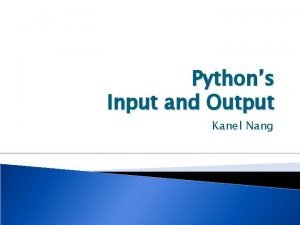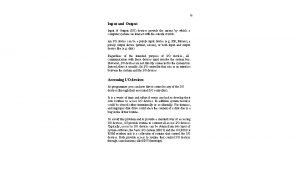Pythons input and output Neev Wanvari Drexel University














- Slides: 14

Python’s input and output Neev Wanvari Drexel University nsw 26@drexel. edu

Output • Python can either print data or output to a file for future use • Handle String manually using string slicing and concatenation operations • Use str. format() method

How to convert to string • Use str() or repr() functions • Many values, such as numbers or structures like lists and dictionaries, have the same representation using either function • Strings and floating point numbers, in particular, have two distinct representations

Example

Using string. format()

Old string formatting • The % operator interprets the left argument much like a sprintf()-style format string to be applied to the right argument, and returns the string resulting from this formatting operation

Reading and Writing Files • open() returns a file object, and is most commonly used with two arguments: open(filename, mode). • The first argument is a string containing the filename. The second argument is another string containing a few characters describing the way in which the file will be used

Different modes • 'r‘- read • 'w‘- write (an existing file with the same name will be erased) • 'a‘- append; any data written to the file is automatically added to the end • 'r+' read and write • The mode argument is optional; 'r' will be assumed if it’s omitted

Methods of File Objects • f. read(size) reads some quantity of data and returns it as a string • size is an optional numeric argument • When size is omitted or negative, the entire contents of the file will be read and returned • If the end of the file has been reached, f. read() will return an empty string (" ")

Methods of File Objects • f. readline() reads a single line from the file • A newline character (n) is left at the end of the string • It is only omitted on the last line of the file if the file doesn’t end in a newline

Methods of File Objects • f. readlines() returns a list containing all the lines of data in the file • Only complete lines will be returned

For loop to read a file • An alternative approach to reading lines is to loop over the file object. • This is memory efficient, fast, and leads to simpler code

Methods of File Objects • f. write(string) writes the contents of string to the file, returning None • To write something other than a string, it needs to be converted to a string first

Thank you
 Drexel download software
Drexel download software Wwwdrexel k12
Wwwdrexel k12 Myers hall drexel
Myers hall drexel Input and output design in system analysis and design
Input and output design in system analysis and design 4 automatic input devices
4 automatic input devices Virtual reality input devices
Virtual reality input devices Input vat and output vat
Input vat and output vat Vat input
Vat input Input vs output vat
Input vs output vat What is output
What is output Input vs output device
Input vs output device Conclusion of output devices
Conclusion of output devices Output devices
Output devices Example of input and output devices in computer
Example of input and output devices in computer Is a scanner an input or output device
Is a scanner an input or output device


























